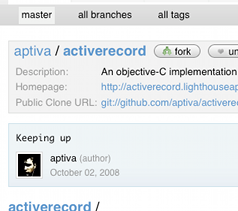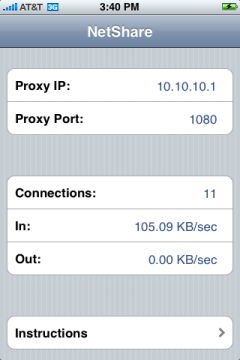I’m pleased to give you
ratos, a shell to speed iPhone development by decoding an entire stack trace at once using atos. Of course as it relies on atos, so it only works on a Mac with Xcode installed.
[301] tako:~> ratos
App Name:TheSnapper
App Path:/Users/face/proj/TheSnapper
Paste xcode stack trace to stdin, then type 'sim' or 'arm' on a line by itself.
Type 'exit' or '^D' to quit and 'app' to print the current app.
ratos>2009-02-05 10:21:31.107 TheSnapper[751:20b] Stack: (
808221155,
806100816,
808224973,
807957033,
807851552,
25785,
22599,
22855,
807923363,
arm
-[BackViewController doubleSnapAction:] (in TheSnapper) (BackViewController.m:192)
-[BackViewController resetAllSiders] (in TheSnapper) (BackViewController.m:126)
-[BackViewController resetSnap:] (in TheSnapper) (BackViewController.m:138)
When I first learned iPhone development it took me a while to find atos. Exception handling comes natural but Xcode spits out addresses in their stack traces. After much googling I finally found atos. I then immediately found Apple’s docs to integrate atos into an exception handler. Cool….NOT!
Turns out Apple’s Xcode integration relies on /usr/bin/atos at runtime….not possible on my iPhone.
So, I immediately wrote a quick and dirty shell in Ruby that takes a stack trace in from xcode, and prints out any lines that have symbols. Gobbledygook in, nice human readable stack trace out!
After enjoying ratos for the past few months I finally had a chance today to clean it up a little and publish it on github.
To use it, first install it on your path.:
git clone git://github.com/face/ratos.git
sudo cp ratos/bin/ratos /usr/local/bin/.
There are a couple environment variables that can be used to configure ratos. Also, if ratos happens to be installed in a project under the directory bin it will self configure. If your application name and directory name are the same and ratos is installed in a shared location like /usr/local/bin, you only need to set
RATOS_APP_PATH:
# csh
setenv RATOS_APP_PATH ~/proj/TheSnapper
# or bash
export RATOS_APP_PATH=~/proj/TheSnapper
If your application name is different than the directory name, you can also set
RATOS_APP_NAME.
Here are some real world examples of how I start up the ratos shell:
[303] tako:~> echo $RATOS_APP_PATH
/Users/face/proj/TheSnapper
[304] tako:~> ratos
App Name:TheSnapper
App Path:/Users/face/proj/TheSnapper
Paste xcode stack trace to stdin, then type 'sim' or 'arm' on a line by itself.
Type 'exit' or '^D' to quit and 'app' to print the current app.
ratos>exit
[305] tako:~> env RATOS_APP_PATH=~/proj/IttyBooks ratos
App Name:TheSnapper
App Path:~/proj/IttyBooks
Paste xcode stack trace to stdin, then type 'sim' or 'arm' on a line by itself.
Type 'exit' or '^D' to quit and 'app' to print the current app.
ratos>exit
[306] tako:~> env RATOS_APP_PATH=~/proj/IttyBooksFree RATOS_APP_NAME=IttyBooks ratos
App Name:IttyBooks
App Path:~/proj/IttyBooksFree
Paste xcode stack trace to stdin, then type 'sim' or 'arm' on a line by itself.
Type 'exit' or '^D' to quit and 'app' to print the current app.
ratos>exit
And finally, here is an example interaction:
[307] tako:~> ratos
App Name:TheSnapper
App Path:/Users/face/proj/TheSnapper
Paste xcode stack trace to stdin, then type 'sim' or 'arm' on a line by itself.
Type 'exit' or '^D' to quit and 'app' to print the current app.
ratos>2009-02-05 10:21:31.107 TheSnapper[751:20b] Stack: (
808221155,
806100816,
808224973,
807957033,
807851552,
25785,
22599,
22855,
807923363,
816119156,
816119004,
816157144,
8381,
8244
)
terminate called after throwing an instance of 'NSException'
arm
-[BackViewController doubleSnapAction:] (in TheSnapper) (BackViewController.m:192)
-[BackViewController resetAllSiders] (in TheSnapper) (BackViewController.m:126)
-[BackViewController resetSnap:] (in TheSnapper) (BackViewController.m:138)
main (in TheSnapper) (main.m:14)
start (in TheSnapper) + 52
ratos>exit
Enjoy!


















